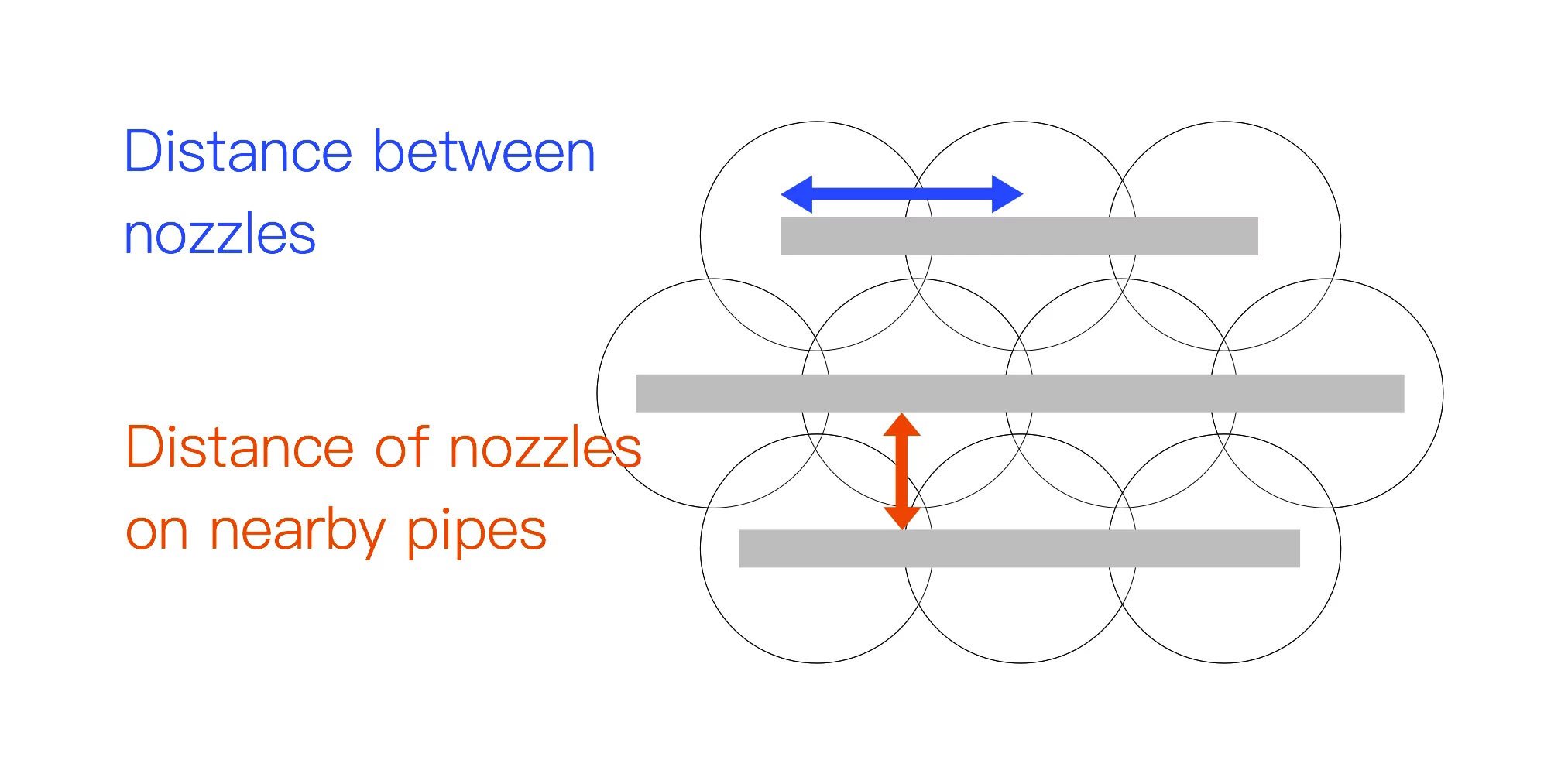สเปรย์แองเกิลคืออะไร?
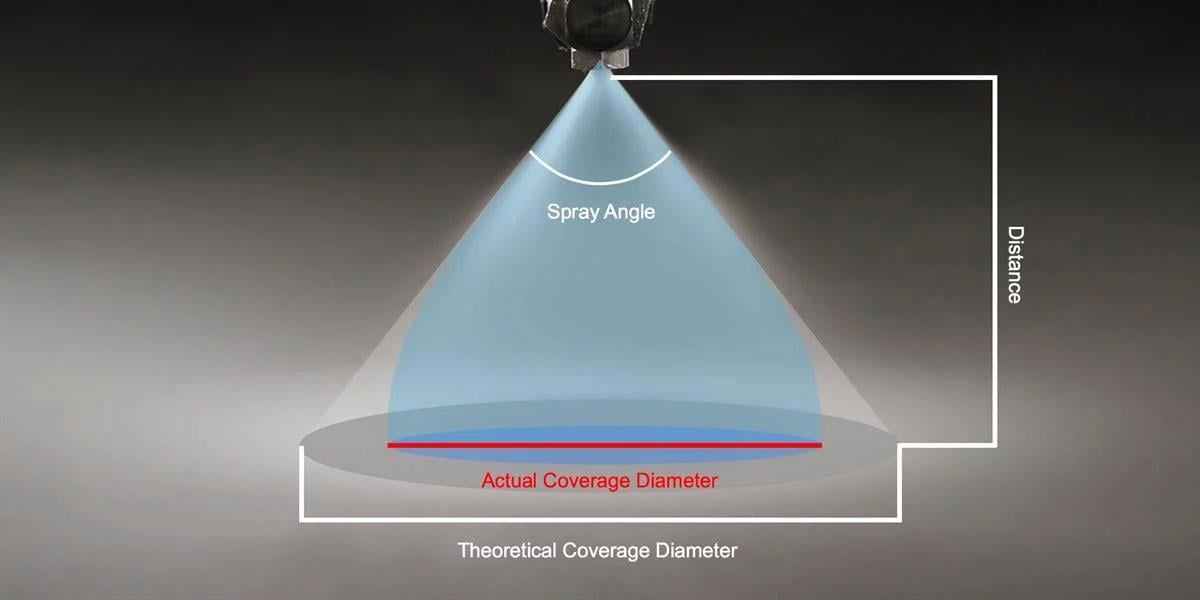
เมื่อเรากล่าวถึง "สเปรย์แองเกิล" (มุมกรวยสเปรย์) หมายถึงมุมที่เกิดขึ้นระหว่างเส้นศูนย์กลางของช่องทางออกของหัวฉีดและขอบของสเปรย์ทั้งสองด้าน หลังจากที่ของเหลวออกจากหัวฉีด มันไม่สามารถเคลื่อนที่ในทิศทางสัมผัสได้เนื่องจากผลของแรงโน้มถ่วงและแรงต้านของอากาศ ทำให้ "พื้นที่ครอบคลุมของสเปรย์จริง" อาจมีขนาดเล็กกว่า "พื้นที่ครอบคลุมของสเปรย์เชิงทฤษฎี
2. วิธีการคำนวณมุมสเปรย์ (Spray Angle)
ปัจจุบันยังไม่มีวิธีมาตรฐานสากลสำหรับการวัดมุมสเปรย์ แต่เทคนิคการวัดที่ใช้กันทั่วไปได้แก่การวัดด้วยโปรแทรกเตอร์และการวัดด้วยแสง
- วิธีการวัดแบบดั้งเดิมด้วยโปรแทรกเตอร์:
หัวฉีดจะถูกยึดให้อยู่ในตำแหน่งแนวนอน ใช้โปรแทรกเตอร์จัดแนวกับขอบของสเปรย์ที่พ่นออกจากศูนย์กลางหัวฉีด และอ่านค่ามุมสเปรย์ วิธีนี้มีต้นทุนต่ำแต่ผลลัพธ์อาจได้รับผลกระทบจากข้อผิดพลาดของมนุษย์
- วิธีการวัดด้วยแสง:
ใช้แหล่งกำเนิดแสงที่เสถียร กล้องความละเอียดสูงจะจับภาพรูปร่างของสเปรย์ จากนั้นใช้ซอฟต์แวร์คอมพิวเตอร์เฉพาะทาง เช่น CAD หรือซอฟต์แวร์ประมวลผลภาพ เพื่อคำนวณมุมสเปรย์ วิธีนี้มีความแม่นยำสูง แต่ต้องใช้ซอฟต์แวร์ที่มีราคาแพงและความเชี่ยวชาญระดับมืออาชีพ LORRIC ใช้วิธีการวัดด้วยแสงเพื่อรับประกันคุณภาพของหัวฉีดทุกชิ้นก่อนการจัดส่ง
3. วิธีคำนวณพื้นที่การพ่นครอบคลุมในทางทฤษฎี
มุมการพ่นของหัวฉีดได้รับอิทธิพลจากขนาดของช่องเปิดของหัวฉีดและระยะห่างระหว่างหัวฉีดกับพื้นผิวเป้าหมาย ความสัมพันธ์นี้ยังเป็นตัวกำหนดพื้นที่การพ่นครอบคลุมและความหนาแน่นของของเหลวที่กระจายอยู่บนพื้นที่ที่ครอบคลุม
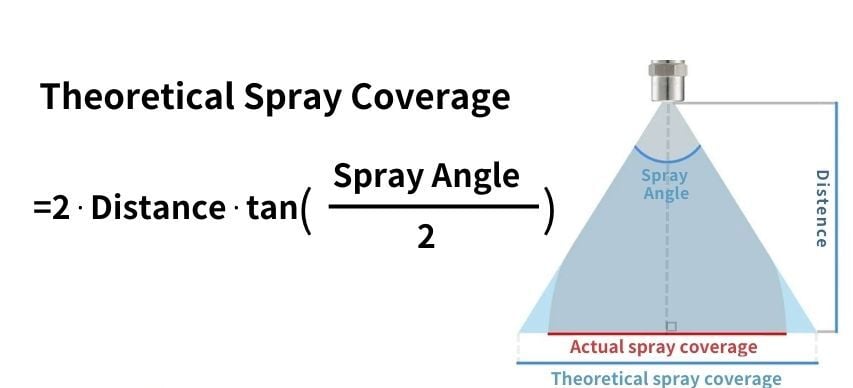
ในการคำนวณพื้นที่การครอบคลุมของการพ่นในทางทฤษฎี เราจำเป็นต้องทราบทั้งมุมการพ่นและระยะทางระหว่างปลายหัวฉีดกับวัตถุ สูตรสำหรับการคำนวณพื้นที่การครอบคลุมการพ่นมีดังนี้:
พื้นที่การครอบคลุมการพ่นในทางทฤษฎี = 2⋅ระยะทาง⋅tan(มุมการพ่น/2)

สรุปได้ว่า ความสัมพันธ์ระหว่างมุมการพ่น พื้นที่ครอบคลุม และระยะห่างคือ: โดยทั่วไป มุมการพ่นที่กว้างขึ้นจะทำให้พื้นที่ครอบคลุมกว้างขึ้น แต่ระยะการพ่นจะสั้นลง ในทางกลับกัน มุมการพ่นที่แคบลงจะทำให้พื้นที่ครอบคลุมแคบลง แต่สามารถพ่นได้ไกลขึ้น
4. ตารางอ้างอิงมุมการพ่นและพื้นที่ครอบคลุม
LORRIC จัดทำตารางอ้างอิงแสดงมุมการพ่นที่คำนวณได้และพื้นที่ครอบคลุมที่สอดคล้องกันตามสูตรที่ใช้คำนวณ อย่างไรก็ตาม ควรทราบว่าปัจจัยต่างๆ เช่น แรงโน้มถ่วงและการเบี่ยงเบนทางอากาศพลศาสตร์ อาจทำให้มุมการพ่นคงอยู่ได้ในระยะทางที่จำกัด โดยปกติไม่เกิน 300 มม. จากช่องทางออกของหัวฉีด
หน่วย: นิ้ว
มุมการพ่น (°)
|
พื้นที่การพ่นครอบคลุมทางทฤษฎี (หน่วย: นิ้ว)
|
| 40 |
55 |
60 |
65 |
70 |
75 |
80 |
90 |
100 |
120 |
170 |
|
ระยะห่าง
(inch)
|
1.0
|
0.7 |
1.0 |
1.2 |
1.3 |
1.4 |
1.5 |
1.7 |
2.0 |
2.4 |
3.5 |
23 |
|
1.5
|
1.1 |
1.6 |
1.7 |
1.9 |
2.1 |
2.3 |
2.5 |
3.0 |
3.6 |
5.2 |
34 |
|
2.0
|
1.5 |
2.1 |
2.3 |
2.5 |
2.5 |
2.8 |
4.2 |
4.0 |
6.0 |
8.7 |
57 |
|
2.5
|
1.8 |
2.6 |
2.9 |
3.2 |
3.5 |
3.8 |
5.0 |
5.0 |
7.2 |
10 |
69 |
|
3.0
|
2.2 |
3.1 |
3.5 |
3.8 |
4.2 |
4.6 |
5.0 |
6.0 |
7.2 |
10 |
69 |
|
3.5
|
2.5 |
3.6 |
4.0 |
4.5 |
4.9 |
5.4 |
5.9 |
7.0 |
8.3 |
12 |
80 |
|
4.0
|
2.9 |
4.2 |
4.6 |
5.1 |
5.6 |
6 |
6.7 |
8.0 |
10 |
14 |
91 |
|
4.5
|
3.3 |
4.7 |
5.2 |
5.7 |
6.3 |
7 |
7.6 |
9.0 |
11 |
16 |
103 |
|
5
|
3.6 |
5.2 |
5.8 |
6.4 |
7 |
8 |
8.4 |
10 |
12 |
17 |
114 |
|
6
|
4.4 |
6.2 |
6.9 |
7.6 |
8 |
9 |
10 |
12 |
14 |
21 |
137 |
|
7
|
5.1 |
7.3 |
8.1 |
8.9 |
10 |
11 |
12 |
14 |
17 |
24 |
160 |
|
8
|
5.8 |
8.3 |
9 |
10 |
11 |
12 |
13 |
16 |
19 |
28 |
183 |
|
9
|
6.6 |
9.4 |
10 |
11 |
13 |
14 |
15 |
18 |
21 |
31 |
206 |
|
10
|
7.3 |
10.4 |
12 |
13 |
14 |
15 |
17 |
20 |
24 |
35 |
229 |
|
11
|
8.0 |
11.5 |
13 |
14 |
15 |
17 |
18 |
22 |
26 |
38 |
251 |
|
12
|
8.7 |
12.5 |
14 |
15 |
17 |
18 |
20 |
24 |
29 |
42 |
274 |
|
13
|
9.5 |
12 |
15 |
18 |
20 |
22 |
23 |
26 |
31 |
45 |
297 |
|
14
|
10 |
13 |
16 |
17.8 |
19.7 |
21.8 |
24 |
28 |
33 |
48 |
320 |
|
18
|
13 |
19 |
21 |
23 |
25 |
28 |
30 |
32 |
43 |
62 |
411 |
|
20
|
15 |
21 |
23 |
25 |
28 |
31 |
34 |
36 |
48 |
69 |
457 |
|
22
|
16 |
23 |
25 |
28 |
31 |
34 |
37 |
40 |
52 |
76 |
503 |
|
24
|
17 |
25 |
28 |
31 |
34 |
37 |
40 |
44 |
57 |
83 |
549 |
|
26
|
19 |
27 |
30 |
33 |
36 |
40 |
44 |
48 |
62 |
90 |
594 |
|
28
|
20 |
29 |
32 |
36 |
39 |
43 |
47 |
52 |
67 |
97 |
640 |
|
30
|
22 |
31 |
35 |
38 |
42 |
46 |
50 |
56 |
72 |
104 |
686 |
|
32
|
23 |
33 |
37 |
41 |
45 |
49 |
54 |
60 |
76 |
111 |
732 |
|
34
|
25 |
35 |
39 |
43 |
48 |
52 |
57 |
64 |
81 |
118 |
777 |
|
36
|
26 |
37 |
42 |
46 |
50 |
55 |
60 |
60 |
86 |
125 |
823 |
หน่วย: มม
มุมการพ่น (°)
|
พื้นที่การพ่นครอบคลุมทางทฤษฎี(หน่วย: มม.) |
| 55 |
60 |
65 |
70 |
80 |
75 |
90 |
100 |
120 |
|
ระยะห่าง
(mm)
|
30 |
31 |
35 |
38 |
42 |
50 |
46 |
60 |
72 |
104 |
| 40 |
42 |
46 |
51 |
56 |
67 |
61 |
80 |
95 |
139 |
| 50 |
52 |
58 |
64 |
70 |
84 |
77 |
100 |
119 |
173 |
| 60 |
62 |
69 |
76 |
84 |
101 |
92 |
120 |
143 |
208 |
| 70 |
73 |
81 |
89 |
98 |
117 |
107 |
140 |
167 |
242 |
| 80 |
83 |
92 |
102 |
112 |
160 |
123 |
160 |
191 |
277 |
| 90 |
94 |
104 |
115 |
126 |
180 |
138 |
180 |
215 |
312 |
| 100 |
104 |
115 |
127 |
140 |
200 |
153 |
200 |
238 |
346 |
| 110 |
115 |
127 |
140 |
154 |
220 |
169 |
220 |
262 |
381 |
| 120 |
125 |
139 |
153 |
168 |
240 |
184 |
240 |
286 |
416 |
| 130 |
135 |
150 |
166 |
182 |
260 |
200 |
260 |
310 |
450 |
| 140 |
146 |
162 |
178 |
196 |
280 |
215 |
280 |
334 |
485 |
| 150 |
156 |
173 |
191 |
210 |
300 |
230 |
300 |
358 |
520 |
| 200 |
208 |
231 |
255 |
280 |
400 |
307 |
400 |
477 |
693 |
| 250 |
260 |
289 |
319 |
350 |
500 |
384 |
500 |
596 |
866 |
| 300 |
312 |
346 |
382 |
420 |
600 |
460 |
600 |
715 |
1039 |
| 350 |
364 |
404 |
446 |
490 |
700 |
537 |
700 |
834 |
1212 |
| 400 |
416 |
462 |
510 |
560 |
800 |
614 |
800 |
953 |
1386 |
| 450 |
469 |
520 |
573 |
630 |
900 |
691 |
900 |
1073 |
1559 |
| 500 |
521 |
577 |
637 |
700 |
1000 |
767 |
1000 |
1192 |
1732 |
| 550 |
573 |
635 |
701 |
770 |
1100 |
844 |
1100 |
1311 |
1905 |
| 600 |
625 |
693 |
764 |
840 |
1200 |
921 |
1200 |
1430 |
2078 |
| 650 |
677 |
751 |
828 |
910 |
1300 |
998 |
1300 |
1549 |
2252 |
| 700 |
729 |
808 |
892 |
980 |
1400 |
1074 |
1400 |
1668 |
2425 |
| 750 |
781 |
866 |
956 |
1050 |
1500 |
1151 |
1500 |
1788 |
2598 |
| 800 |
833 |
924 |
1019 |
1120 |
1600 |
1228 |
1600 |
1907 |
2771 |
| 850 |
885 |
981 |
1083 |
1190 |
1700 |
1304 |
1700 |
2026 |
2944 |
| 900 |
937 |
1039 |
1147 |
1260 |
1800 |
1381 |
1800 |
2145 |
3118 |
| 950 |
989 |
1097 |
1210 |
1330 |
1900 |
1458 |
1900 |
2264 |
3291 |
| 1000 |
1041 |
1155 |
1274 |
1400 |
2000 |
1535 |
2000 |
2384 |
3464 |
5. เกี่ยวกับมุมและพื้นที่ครอบคลุม
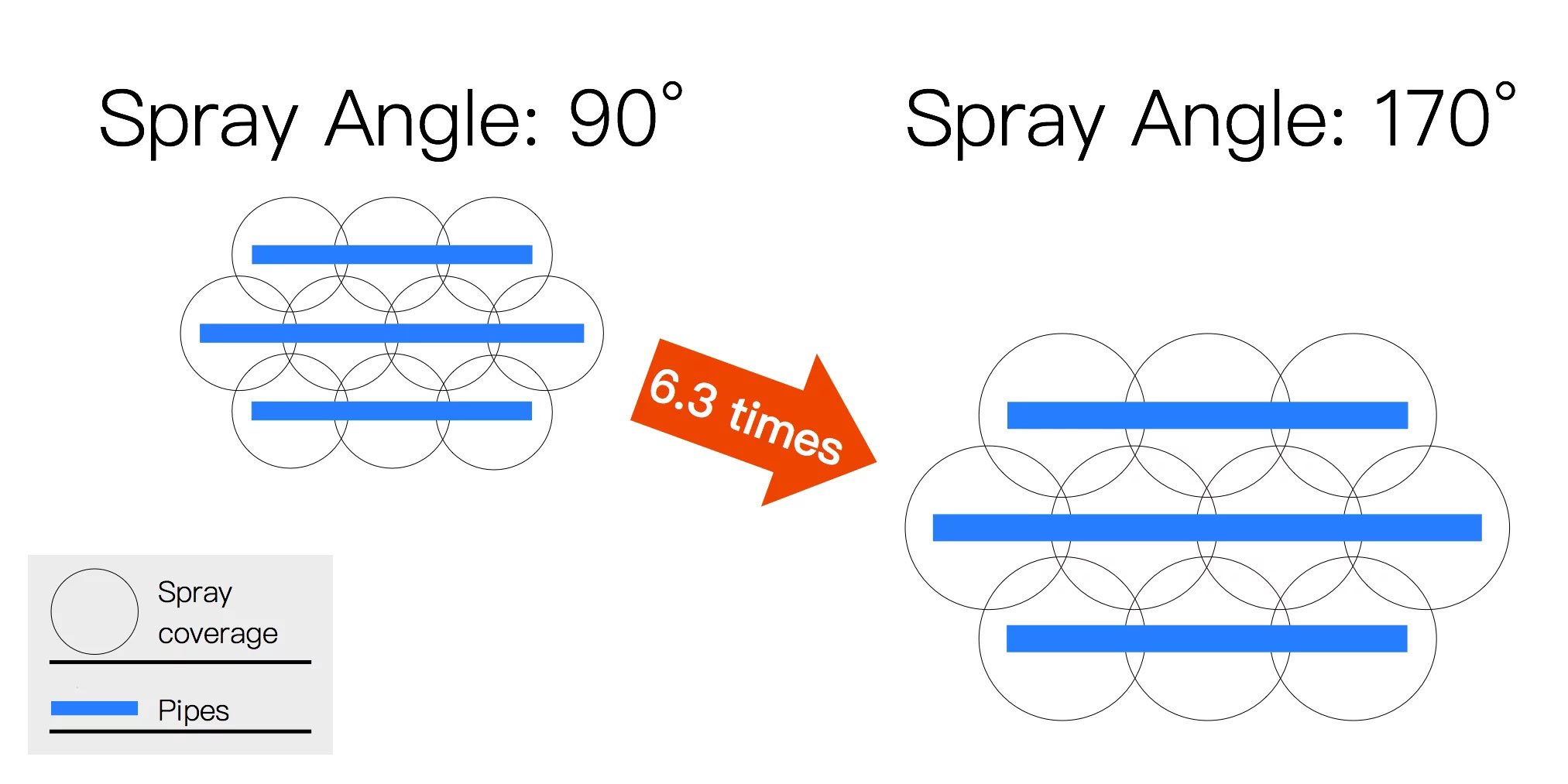
ที่ระยะห่าง 300 มม. พื้นที่การพ่นครอบคลุมทางทฤษฎีมีดังนี้:
- มุม 90°: พื้นที่การพ่น 60 ซม., 0.28㎡ ต่อหน่วย
- มุม 170°: พื้นที่การพ่น 150 ซม., 1.76㎡ ต่อหน่วย (ประมาณ 6.3 เท่าของมุม 90°)
4. 3 ข้อควรพิจารณาที่สำคัญเกี่ยวกับระยะทางในการเลือกมุมหัวฉีด
1 ) ระยะห่างถึงเป้าหมาย
ระยะห่างระหว่างหัวฉีดและพื้นที่เป้าหมาย เช่น หลังคาใบไม้ของพืช มีผลกระทบอย่างมากต่อการกระจายตัวของสเปรย์ การตั้งค่าระยะทางที่เหมาะสมจะช่วยให้ครอบคลุมพื้นที่ได้อย่างมีประสิทธิภาพ ในขณะเดียวกันลดการฟุ้งกระจายและการสูญเปล่า การปรับระยะทางควรพิจารณาประเภทของการพ่นและความต้องการของการใช้งานเฉพาะ เพื่อให้เกิดประสิทธิภาพสูงสุด
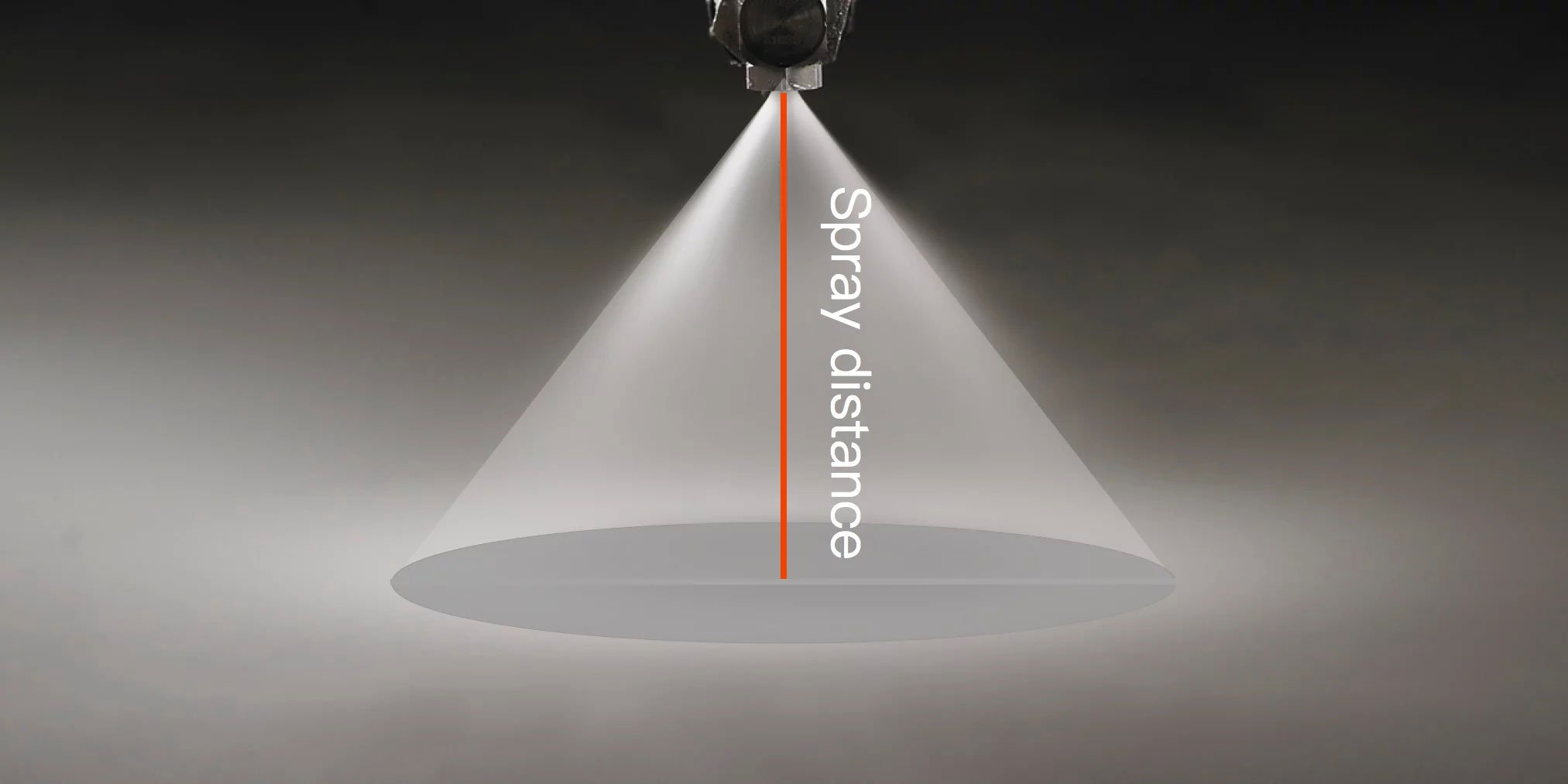
2 ) ระยะห่างระหว่างหัวฉีดที่อยู่ติดกัน
การรักษาระยะห่างที่เหมาะสมระหว่างหัวฉีดที่อยู่ติดกันมีความสำคัญอย่างยิ่งต่อการครอบคลุมพื้นที่เป้าหมายอย่างสม่ำเสมอ หากระยะห่างไม่เหมาะสม อาจทำให้เกิดการทับซ้อนของละอองสเปรย์หรือมีพื้นที่ที่พลาดการครอบคลุม ซึ่งส่งผลต่อประสิทธิภาพโดยรวมของการใช้งาน ระยะห่างนี้จะแตกต่างกันไปขึ้นอยู่กับประเภทของหัวฉีดและรูปแบบการครอบคลุมที่ต้องการ
3 ) ระยะห่างระหว่างแท่งหัวฉีดสเปรย์
สำหรับหัวฉีดที่ไม่ใช่แบบแบน เช่น หัวฉีดทรงกรวยตัน หัวฉีดทรงกรวยกลวง และหัวฉีดแบบเกลียว ระยะห่างระหว่างแท่งหัวฉีดสเปรย์มีบทบาทสำคัญในการเลือกมุม และส่งผลต่อรูปแบบการครอบคลุมและประสิทธิภาพของการพ่น การปรับระยะที่เหมาะสมจะช่วยให้เกิดการทับซ้อนของสเปรย์ที่เหมาะสมและการกระจายตัวที่สม่ำเสมอในพื้นที่เป้าหมาย
